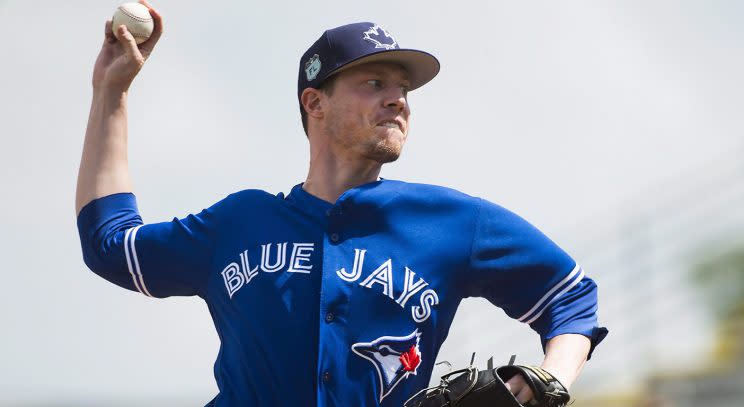Why Blue Jays continue to have starting depth issues

In the grand scheme of things, the Toronto Blue Jays are in an enviable position when it comes to starting pitching.
Their rotation may be hard-pressed to replicate last year’s success, but this is a unit where Aaron Sanchez is starting the team’s fifth game. One could certainly argue that this isn’t the optimal alignment, but for the vast majority of teams in the league it would be unfathomable.
With Sanchez, Marco Estrada, J.A. Happ, Marcus Stroman and Francisco Liriano, the Blue Jays have a potent Megazord that figures to keep the club in almost every game.
Where things start to get hairy for Toronto is on starter No. 6. Technically, it’s a position that doesn’t exist seeing as the five-man rotation is ubiquitous in the game. Even so, while sixth starters are absent from the opening day programs, they are essential in practice.
This is an easy thing for Blue Jays fans to forget given the way last season went. Toronto got 152 starts from the rotation it began the season with. Eight more starts were delivered by Liriano, who the team traded for. Only two starts came from a pitcher — Drew Hutchison — who they didn’t make an active effort to put on the mound.
In 2017, the chances of them being as lucky are infinitesimal. Conversely, when the injury bug likely strikes the Blue Jays are in a worse position than they were last season. Instead of having a Hutchison type waiting in the wings, the depth options are guys like Mike Bolsinger (if they carry him in the bullpen), Mat Latos, Lucas Harrell and Casey Lawrence.
Blue Jays management is well aware that this is not an ideal situation. On the FAN 590 on Friday, team president Mark Shapiro summarized his club’s predicament candidly:
“If you said ‘what’s your one fear heading into the season,’ it probably would be the drop-off from our fifth starter to our sixth starter. That’s not a subtle drop-off”
If someone in the rotation goes down early in the season, there really isn’t a pitcher the Blue Jays have in the fold who they’d want to see make double-digit starts. Considering the strong likelihood of one of the Blue Jays’ top five missing time this year, this seems like a crucial team-building error.
However, as it turns out going out and getting a sixth starter is a devilishly difficult proposition. If you’re looking to hunt one down in the offseason you need a pitcher who fits the following criteria to some degree:
Good enough that you’re not terrified to run him out there
Pretty intuitive criterion here, if a pitcher is liable to get crushed every time out he’s not worth it even as a depth option. This is why you don’t rush out to get yourself Tim Lincecum, no matter how much it sounds like a cool idea.
Considered relatively durable
If your whole job is to be a health insurance policy for someone else, it’s not very helpful if you’re made of glass. This rules out the talented but unreliable Jarrod Parker and Henderson Alvarez types.
Doesn’t have job prospects in a major-league rotation OR bullpen
This is the most important caveat that makes finding starting depth so difficult. If a pitcher is good enough that you feel comfortable with them on the mound, someone else probably considers them a worthy piece for their rotation or someone with potential as a relief conversion project.
As a result, it’s almost impossible to find your ideal sixth starter in free agency. Ditto for the trade market where every team in baseball sees the value in rotation depth and pitchers with team control. Also, the idea of trading something concrete for a player who won’t start the season with your team and may not factor in at all — like Hutchison in 2016 — isn’t exactly exciting.
Ultimately, there’s only one way to get yourself a good sixth starter: develop one. That’s not happening for the Blue Jays this season. Their top pitching prospect, Sean Reid-Foley, pitched at Single-A Dunedin last year and their second, Conner Greene, barely struck out more hitters than he walked at Double-A. He would need a huge jump to be big-league ready. The next tier of guys like T.J. Zeuch and Jon Harris are a ways away if they arrive at all.
One of the results of the club’s 2015 trade deadline dealing was a massive exodus of young pitching talent. Daniel Norris would likely be a rotation staple for the Blue Jays by now if they’d kept him, but Matt Boyd and Jeff Hoffman are exactly the ideal sixth starter prototypes. They are both pitchers who are ready to contribute yet have something to gain from honing their skills at Triple-A. The Rockies feel exactly that way as they sent Hoffman down on Thursday. Boyd looks likely to be the Detroit Tigers’ fifth starter, but he’d surely be No. 6 in a superior Toronto rotation.
When the offseason began, starting depth looked like a huge issue and it’s something that Shapiro and Co arguably failed to address. However, it really was an unsolvable problem for this front office. If you don’t have the young pitching you’re going to end up with a rag-tag band of veteran reclamation projects, as the team does now. Until the Blue Jays develop quality depth, they’re never going to have it.

 Yahoo Sports
Yahoo Sports 

